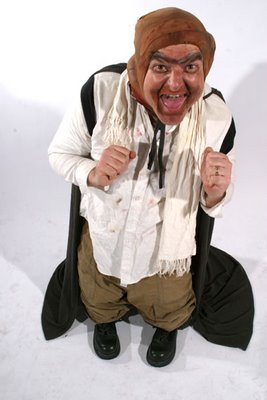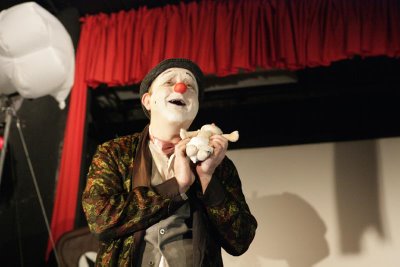 1) What the fuck is going on?
1) What the fuck is going on?
Clown, man. And I’m not talking about bad red afro-wigged primary-coloured face-painted children’s clown. I’m talking theatrical clown.
2) Is there an essential “clowness” that all clowns aspire to?
I think that all styles of clown like to have a sense of play about them. If a clown enters a scene with a non-clown you know that the clown is going to mess things up for that person. For me the essential thing to aspire to is to be honest about my character’s emotions. To me bad clowning is where the clown goes into over-the-top silent movie style acting to convey their feelings. It is much better to just feel the emotion, turn out to the audience, look them in the eyes and breathe. People are very good at recognizing body language, you don’t have to hit them on the head with a rubber chicken.
3) What’s the difference between theatrical clowning and theatrical acting?
The fourth wall. When a clown walks out on to the stage, the most interesting thing they see is the audience. Actors will go to great lengths to pretend that no one is there. If you cough in a clown show the clowns will acknowledge that and deal with it. I’ve seen outdoor dramatic theatre shows where a plane flies overhead and the actors have to pretend that it didn’t happen. As a clown I love it if an audience member starts talking or gets a phone call or arrives late or leaves early. It allows me to deal directly with them and gives me a chance to work with the audience and to temporarily get out of any prepared storyline. Another difference is playing neutral. For an actor neutral is devoid of feeling or emotion – for a clown it is feeling everything at once in balance. Clown neutral holds a lot of tension as the clown could burst out into any emotion. Oh, and a bunch of clowns are harder to direct than actors.
4) Do children and adults tend to find clowns amusing in the same way?
Kids have a more limited palette of emotions that they are interested in seeing and they don’t have a lot of patience for the setup of a scene. I for one much prefer working with adults as they can handle a more intellectual approach to storytelling. Adults will grant you around two minutes before anything really has to happen on stage. For kids you get about ten seconds. However, kids are more open to interacting with a performer on stage. Adults take more cajoling to get up on stage with you or to do something you ask them. Mind you, alcohol is the great equalizer for that sort of thing. I have the most fun with slightly drunk audiences. Drunk children’s audiences are the best.
 5) How does makeup and costume fit into a clown performance?
5) How does makeup and costume fit into a clown performance?
Clowning involves deep character work. I find that it is much easier to allow yourself to go into character if you have something to hide your actual self behind. The red nose is the smallest mask that makes a big impact on the face. Somehow a red nose allows you to be a bit bigger than you would normally be allowed to go. I love doing stuff in costume, as soon as I put one on I get the impulse to change my posture, voice and even my outlook on life. As a clown I have dozens of boxes full of costumes and way more makeup than my wife (and I wear it more often too).
6) Do you have any unifying theories when it comes to comedy?
I also do sketch and improv so I have seen things that can work across those types of comedy too. Two things stand out for me:
1. Be specific with detail.
2. Surprise with the obvious response.
Detail makes a scene more real to people and gets their imagination involved. People’s imaginations are funnier than you are. A really good example of this was in the movie The Aristocrats. The movie is all about a single joke. When George Carlin tells it he sets the bar with funny because he gets into such detail that you can see, smell and taste what he is talking about even though you would rather not.
Using the obvious response works well in improv and clown as you are often put on the spot to react to something that you did not expect. If you respond with the most obvious thing that character would do it makes people laugh. Sometimes they laugh because they expected and wanted the character to do that and sometimes they laugh because they did not think of it themselves but in retrospect it was obvious that that’s what the character would actually do.
 7) Assuming there are different types of clowns, what kind of clown are you?
7) Assuming there are different types of clowns, what kind of clown are you?
I consider myself a Pochinko clown. The late Richard Pochinko created a Canadian-specific form of clowning by combining traditional European clown with native American shamanistic mask work. It is somewhere between theatrical training and mysticism. It is also called clown through mask. The process involves breaking down your personality and experiences into little stories and from that building up a vocabulary or palette of masks that your clown uses to express itself. You end up with twelve masks that have sophisticated emotions attached to them that you can jump between. Eventually in the training all of the masks are fused into your little red nose. The nose embodies all aspects of the clown.
I also do bouffon. Bouffon is a dark cousin of clown. It is quite different from clown in that while the clown takes people on a little journey and promises to keep them safe, the bouffon takes them on a journey and pushes them off the cliff. Bouffon uses mockery and satire to chide authority. A good example would be Stephen Colbert from the Daily Show. He makes fun of Republicans by being one and taking their opinions to an extreme. Most of the local bouffons perform as outcast characters. Grotesques, whores and transvestites are popular characters in the bouffon scene. I have a midget character that I play with shoes on my knees, large cancerous lumps on my head and several missing teeth. The goal of the bouffon is to be so funny while mocking authority figures that the authority figures laugh until they realize that they are the source of the humour and they die of a heart attack. I haven’t killed anyone yet with my mockery, but I’m working at it.
8) How fine is the line between a comedic clown and a tragic clown?
I don’t see a line there at all, tragedy can be very funny. I find using clown is great for exploring topics that people are not comfortable with. Death, sex and pretty much anything normally taboo is open to explore in clown. I wrote a play about the experiences of my brother who was born intellectually challenged. When I swapped intellectually challenged for clown I was able to explore the issues and show the comedy without having people’s sense of political correctness ruin the point and message of the work. It is OK to see a clown’s entire life collapse around them because they are just playing that it is happening. That gives the audience a feeling of comfort with being able to laugh. Kicking a man while he is down is not funny unless he has a big red nose.
9) What’s the role of the sad clown?
I’ve had this question before. I think this whole concept of the “sad clown” is something that has been romanticized by oil on velvet paintings. A good clown should be able to go through all emotions through their masks. I do like to milk an “awwww” from the audience in situations where you have reason to be sad. Sadness is expressed well using the eyes and mouth and those are the best tools for a clown to work an emotion. I guess my answer would be that the sad clown makes a good covering for a dent in the wall in your den.
10) Any tips on how a non-clown performer could incorporate clown craft and techniques into their own work?
I think people should study clown and bouffon even if they don’t want to pursue it. It can give you a whole set of skills that are applicable to any performance style. In just about every style of performance that I have encountered breathing is one of the most important things you can do. With clown there is no fourth wall so breathing along with your audience can put them at ease. If you want to make your audience tense, stop breathing. They will have a hard time breathing until you do it again yourself. Taking a big breath and letting it out while looking at your audience is a great way to present yourself and to let them know how you feel.
A few clown comedy tricks that you can use in comedy are the rule of threes and more, more, more.
The rule of threes is doing something three times, the first two the same, and then change it up on the third. People spot a pattern after two times, anticipate a third and then you surprise them. Works great for all ages. If you find you are doing something that the audience loves, let them know that you recognize that and go big with whatever it is until it has peaked. In commedia d’ell arte they call that a lazzi. Where you just get bigger and more outrageous until you hit a peak.
Clown is also good for feeling your impulses. When you walk on stage you feel an impulse on when to stop moving towards your audience, while performing you might feel impulses to change up what you are doing and when you feel the impulse to get off stage you know you are done. You are better off feeling the impulse than trying to think it through. Your body knows better than your mind. Trust it.
no offence to all my praxis homies, but this is my favourite 10 questions yet. who will they get next? you never know.
Very insightful. I’ve been looking at Eugene Levy’s sketch character Bobby Bittman again lately, and this idea of Bouffon seems to fit with what he’s doing there.